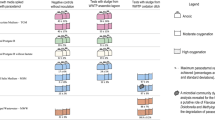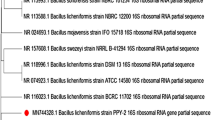Abstract
Bacterial isolates with the capacity to remove paracetamol were selected from an activated sludge sample collected in an oxidation ditch of a wastewater treatment plant. Among these, twelve bacterial isolates were selected according to their capacity to grow in the presence of paracetamol. They were identified using the colony morphotype procedure and by 16S rRNA gene sequencing analysis, but only four of them showed the ability to utilise paracetamol as the sole carbon source in the presence of a nitrogen supply. Those four bacterial isolates were assigned to species of the genera Bacillus, [Brevibacterium], Corynebacterium and Enterococcus. Bacterial isolates were cultured in liquid mineral salt medium (MSM) spiked with 200 mg/L of paracetamol at 28 °C in the dark. In cultures inoculated with [Brevibacterium] frigoritolerans, Corynebacterium nuruki and Enterococcus faecium, removal of 97 ± 4%, 97 ± 6% and 86.9 ± 0.8% of paracetamol at 200 mg/L were obtained, respectively, while in the presence of a species belonging to Bacillus cereus group removal of the drug below the limits of detection was attained with evidence of mineralisation, after 144 h of incubation. During the degradation process, the metabolites 4-aminophenol, hydroquinone and 2-hexenoic acid were detected. As far as we know, these species are herein first-time described as paracetamol degraders.

source compared with each type strains. Node numbers represent bootstrap values (percentage of 500 replications)


Similar content being viewed by others
References
Xu JJ, Hendriks BS, Zhao J, Graaf D (2008) Multiple effects of acetaminophen and p38 inhibitors: towards pathway toxicology. FEBS Lett 582:1276–1282. https://doi.org/10.1016/j.febslet.2008.01.063
Vymazal J, Březinová TD, Koželuh M, Kule L (2017) Occurrence and removal of pharmaceuticals in four full-scale constructed wetlands in the Czech Republic—the first year of monitoring. Ecol Eng 98:354–364. https://doi.org/10.1016/j.ecoleng.2016.08.010
Joss A, Zabczynski S, Göbel A, Hoffmann B, Löffler D, McArdell CS, Ternes TA, Thomsen A, Siegrist H (2006) Biological degradation of pharmaceuticals in municipal wastewater treatment: Proposing a classification scheme. Water Res 40(8):1686–1696. https://doi.org/10.1016/j.watres.2006.02.014
Kasprzyk-Hordern B, Dinsdale RM, Guwy AJ (2009) The removal of pharmaceuticals, personal care products, endocrine disruptors and illicit drugs during wastewater treatment and its impact on the quality of receiving waters. Water Res 43:363–380. https://doi.org/10.1016/j.watres.2008.10.047
Papageorgiou M, Kosma C, Lambropoulou D (2016) Seasonal occurrence, removal, mass loading and environmental risk assessment of 55 pharmaceuticals and personal care products in a municipal wastewater treatment plant in Central Greece. Sci Total Environ 543:547–569. https://doi.org/10.1016/j.scitotenv.2015.11.047
Pereira AMPT, Silva LJG, Linoa CM, Meisel LM, Pena A (2016) Assessing environmental risk of pharmaceuticals in Portugal: an approach for the selection of the Portuguese monitoring stations in line with directive 2013/39/EU. Chemosphere 144:2507–2515. https://doi.org/10.1016/j.chemosphere.2015.10.100
Roberts PH, Thomas KV (2006) The occurrence of selected pharmaceuticals in wastewater effluent and surface waters of the lower Tyne catchment. Sci Total Environ 356:143–153. https://doi.org/10.1016/j.scitotenv.2005.04.031
Wilkinson J, Hooda PS, Barker J, Barton S, Swinden J (2017) Occurrence, fate and transformation of emerging contaminants in water: an overarching review of the field. Environ Pollut 231(1):954–970. https://doi.org/10.1016/j.envpol.2017.08.032
Jallouli N, Elghniji K, Trabelsi H, Ksibi M (2017) Photocatalytic degradation of paracetamol on TiO2 nanoparticles and TiO2/cellulosic fiber under UV and sunlight irradiation. Arab J Chem 10(2):S3640–S3645. https://doi.org/10.1016/j.arabjc.2014.03.014
Scott PD, Bartkow M, Blockwell SJ, Coleman HM, Khan SJ, Lim R, McDonald JA, Nice H, Nugegoda D, Pettigrove V, Tremblay LA, Warne MS, Leusch FD (2014) A national survey of trace organic contaminants in Australian rivers. J Environ Qual 43(5):1702–1712. https://doi.org/10.2134/jeq2014.01.0012
Brumovský M, Bečanová J, Kohoutek J, Borghini M, Nizzetto L (2017) Contaminants of emerging concern in the open sea waters of the western Mediterranean. Environ Pollut 229:976–983. https://doi.org/10.1016/j.envpol.2017.07.082
Palma TL, Donaldben MN, Costa MC, Carlier JD (2018) Putative role of Flavobacterium, Dokdonella and Methylophilus strains in paracetamol biodegradation. Water Air Soil Pollut 229:200. https://doi.org/10.1007/s11270-018-3858-2
Peake BM, Braund R, Tong A, Louis A (2015) The life cycle of pharmaceuticals in the environment. In: Biomedicine. Woodhead Publishing Series, Cambridge, pp 110–136
Wu S, Zhang L, Chen J (2012) Paracetamol in the environment and its degradation by microorganisms. Appl Microbiol Biotechnol 96(4):875–884. https://doi.org/10.1007/s00253-012-4414-4
Marchlewicz A, Guzik U, Hupert-Kocurek K et al (2017) Toxicity and biodegradation of ibuprofen by Bacillus thuringiensis B1(2015b). Environ Sci Pollut Res 24(8):7572–7584. https://doi.org/10.1007/s11356-017-8372-3
De Gusseme B, Vanhaecke L, Verstraete W, Boon N (2011) Degradation of acetaminophen by Delftia tsuruhatensis and Pseudomonas aeruginosa in a membrane bioreactor. Water Res 45:1829–1837. https://doi.org/10.1016/j.watres.2010.11.040
Zhang L, Hu J, Zhu R, Zhou Q, Chen J (2013) Degradation of paracetamol by pure bacterial cultures and their microbial consortium. Appl Microbiol Biotechnol 97(8):3687–4369. https://doi.org/10.1007/s00253-012-4170-5
Karaman R, Khamis M, Abbadi J, Amro A, Qurie M, Ayyad I, Ayyash F, Hamarsheh O, Yaqmour R, Nir S, Bufo SA, Scrano L, Lerman S, Gur-Reznik S, Dosoretz CG (2016) Paracetamol biodegradation by activated sludge and photocatalysis and its removal by a micelle–clay complex, activated charcoal, and reverse osmosis membranes. Environ Technol 37(19):2414–2427. https://doi.org/10.1080/09593330.2016.1150355
Abdullah QY, Edrees WH, AL-Kaf AG, Naji KM (2018) Biodegradation of paracetamol by native bacterial strains isolated from Yemeni pharmaceutical wastewater plant in Sana’a. Chron Pharm Sci 2:512–522
Çeçen F, Gül G (2021) Biodegradation of five pharmaceuticals: estimation by predictive Models and comparison with activated sludge data. Int J Environ Sci Technol 18:327–340. https://doi.org/10.1007/s13762-020-02820-y
Lebaron P, Ghiglione J-F, Fajon C, Batailler N, Normand P (1998) Phenotypic and genetic diversity within a colony morphotype. FEMS Microbiol Lett 160:137–143. https://doi.org/10.1111/j.1574-6968.1998.tb12903.x
Fleury V, Gouyet J-F, Leonetti M (2001) Branching in Nature. Dynamics and morphogenesis of branching structures, from cell to river networks. Centre de Physique des Houches. Springer-Verlag, Berlin, Heidelberg
Palma TL, Shylova A, Costa MC (2021) Isolation and characterization of bacteria from activated sludge capable of degrading 17α-ethinylestradiol, a contaminant of high environmental concern. Microbiology. https://doi.org/10.1099/mic.0.001038
Kumar S, Stecher G, Li M, Knyaz C, Tamura K (2018) MEGA X: molecular evolutionary genetics analysis across computing platforms. Mol Biol Evol 35:1547–1549. https://doi.org/10.1093/molbev/msy096
Tamura K, Nei M (1993) Estimation of the number of nucleotide substitutions in the control region of mitochondrial DNA in humans and chimpanzees. Mol Biol Evol 10:512–526. https://doi.org/10.1093/oxfordjournals.molbev.a040023
Kobori H, Sullivan CW, Shizuya H (1984) Bacterial plasmids in Antarctic natural microbial assemblages. Appl Environ Microbiol 48(3):515–518
Shimizu K (2013) Regulation systems of bacteria such as Escherichia coli in response to nutrient limitation and environmental stresses. Metabolites 4(1):1–35. https://doi.org/10.3390/metabo4010001
Robador A, LaRowe DE, Finkel SE, Amend J, Nealson KH (2018) Changes in microbial energy metabolism measured by nanocalorimetry during growth phase transitions. Front Microbiol 1(9):109. https://doi.org/10.3389/fmicb.2018.00109
Logan NA (2010) Bacillus anthracis, Bacillus cereus, and Other Aerobic endospore-forming bacteria. In: Boriello SP, Murray PR, Funke G (eds) Topley and Wilson’s Microbiology and Microbial Infections. Wiley, Hoboken, pp 922–952
Liu Y, Du J, Lai Q, Zeng R, Ye D, Xu J, Shao Z (2017) Proposal of nine novel species of the Bacillus cereus group. Int J Syst Evol Microbiol 67:2499–2508. https://doi.org/10.1099/ijsem.0.001821
Miller RA, Beno SM, Kent DJ, Carroll LM, Martin NH, Boor KJ, Kovac J (2016) Bacillus wiedmannii sp. nov. a psychrotolerant and cytotoxic Bacillus cereus group species isolated from dairy foods and dairy environments. Int J Syst Evol Microbiol 66(11):4744–4753. https://doi.org/10.1099/ijsem.0.001421
Liu Y, Lai Q, Göker M, Meier-Kolthoff JP, Wang M, Sun Y, Wang L, Shao Z (2015) Genomic insights into the taxonomic status of the Bacillus cereus group. Sci Rep 16(5):14082. https://doi.org/10.1038/srep14082
Gelsomino R, Vancanneyt M, Vandekerckhove TM, Swings J (2004) Development of a 16S rRNA primer for the detection of Brevibacterium spp. Lett Appl Microbiol 38:532–535. https://doi.org/10.1111/j.1472-765X.2004.01533.x
Beesley CA, Vanner CL, Helsel LO, Gee JE, Hoffmaster AR (2010) Identification and characterization of clinical Bacillus spp. isolates phenotypically similar to Bacillus anthracis. FEMS Microbiol Lett 313(1):47–53. https://doi.org/10.1111/j.1574-6968.2010.02120.x
Hu X, Wang J, Wang F, Chen Q, Huang Y, Zhongli C (2014) Complete genome sequence of the p-nitrophenol-degrading bacterium Pseudomonas putida DLL-E4. Genome A 2(3):e00596-e614. https://doi.org/10.1128/genomeA.00596-14
Siezen RJ, Kuipers OP, de Vos WM (1996) Comparison of lantibiotic gene clusters and encoded proteins. Antonie Van Leeuwenhoek 69(2):171–184. https://doi.org/10.1007/BF00399422
Rodríguez J, Oviedo C (2003) EDTA: the chelating agent under environmental scrutiny. Quim Nova 26(6):901–905. https://doi.org/10.1590/S0100-40422003000600020
Henneken L, Nörtemann B, Hempel DC (1995) Influence of physiological conditions on EDTA degradation. Appl Microbiol Biotechnol 44:190–197. https://doi.org/10.1007/BF00164501
Crosby HA, Kwiecinski J, Horswill AR (2016) Staphylococcus aureus aggregation and coagulation mechanisms, and their function in host-pathogen interactions. Advances in Applied Microbiology. Elsevier, Amsterdam, pp 1–41. https://doi.org/10.1016/bs.aambs.2016.07.018
Fioravante IA, Albergaria B, Teodoro TS, Magalhães SMS, Barbosa F, Augusti R (2012) Removal of 17α-ethinylestradiol from a sterile WC medium by the cyanobacteria Microcystis novacekii. J Environ Monit 14(9):2362–2366. https://doi.org/10.1039/c2em30320e
Moreira IS, Ribeiro AR, Afonso CM, Tiritan ME, Castro PML (2014) Enantioselective biodegradation of fluoxetine by the bacterial strain Labrys portucalensis F11. Chemosphere 111:103–111. https://doi.org/10.1016/j.chemosphere.2014.03.022
IARC Monographs (2020) Paracetamol, 50:307–332. https://monographs.iarc.fr/wp-content/uploads/2018/06/mono50-20.pdf. Accessed 23 july 2020
Dietlin F, Fredj D (2000) Stable liquid paracetamol compositions, and method for preparing same. United States Scr, Pharmatop (FR) 6028222. http://www.freepatentsonline.com/6028222.html.Accessed on 23 july 2020
Chiam E, Weinberg L, Bellomo R (2015) Paracetamol: a review with specific focus on the haemodynamic effects of intravenous administration. Heart Lung Vessel 7(2):121–132
Khamis M, Karaman R, Ayyash F, Qtait A, Deeb O, Manssra A (2011) Efficiency of advanced membrane wastewater treatment plant towards removal of aspirin, salicylic acid, paracetamol and p-Aminophenol. Indian J Environ Health 5:121–137
Ahmed Z, Sarwar Z, Ahmad N, Hussain MS, Riazuddin S (1999) Genetic modification of Pseudomonas putida for enhanced degradation of phenol and nitrophenol. Pak J Biochem Mol Biol 32:32–37
Li J, Ye Q, Gan J (2014) Degradation and transformation products of acetaminophen in soil. Water Res 49:44–52. https://doi.org/10.1016/j.watres.2013.11.008
Westphal GA, Bünger J, Lichey N, Taeger D, Mönnich A, Hallier E (2009) The benzene metabolite para-benzoquinone is genotoxic in human, phorbol-12-acetate-13-myristate induced, peripheral blood mononuclear cells at low concentrations. Arch Toxicol 83(7):721–729. https://doi.org/10.1007/s00204-009-0402-6
Funding
The authors would like to thank Fundação para a Ciência e a Tecnologia (FCT) for funding this research through the PhD grant SFRH/ BD/95075/2013 and through the Centro de Ciências do Mar’s Plurianual (UIDB/04326/2020). Financial support was obtained through project 0483_PROBIOMA_5_E, co-financed by the European Regional Development Fund within the framework of the Interreg V-A Spain-Portugal program (POCTEP) 2014–2020.
Author information
Authors and Affiliations
Contributions
TP carried out the experimental work and wrote the article as part of her PhD. GM collaborated on part of the experimental work. Prof. MCC supervised the experimental work, corrected, and revised the manuscript. All authors read and approved the final manuscript.
Corresponding author
Ethics declarations
Conflict of interest
The authors declare that they have no conflict of interest.
Additional information
Publisher's Note
Springer Nature remains neutral with regard to jurisdictional claims in published maps and institutional affiliations.
Supplementary Information
Below is the link to the electronic supplementary material.
Rights and permissions
About this article
Cite this article
Palma, T.L., Magno, G. & Costa, M.C. Biodegradation of Paracetamol by Some Gram-Positive Bacterial Isolates. Curr Microbiol 78, 2774–2786 (2021). https://doi.org/10.1007/s00284-021-02543-4
Received:
Accepted:
Published:
Issue Date:
DOI: https://doi.org/10.1007/s00284-021-02543-4




